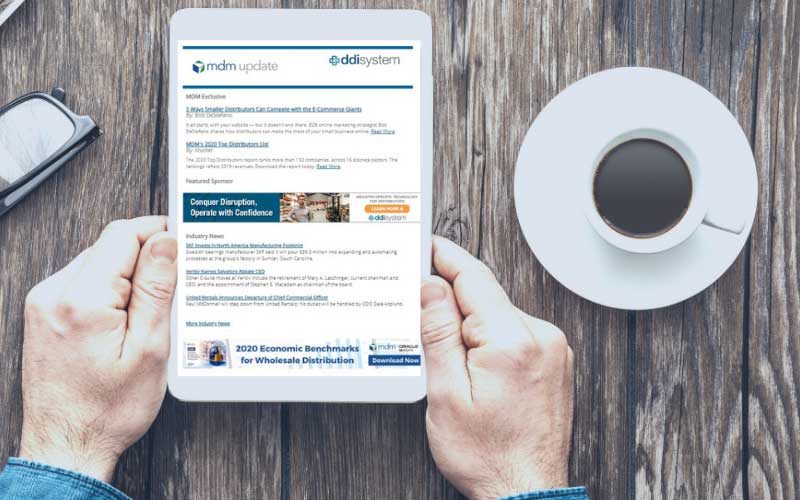Editor’s Note: This is the third installment in our ‘Executive Input’ blog series sponsored by DataXstream that extracts key takeaways from short interviews with distribution executives — often answering three straightforward questions about challenges they are trying to solve with technology. These leaders could opt to have their name and company omitted from the blog to speak freely. Keep an eye out for more to come.
————————
Good thing no one was around to see Cinderella’s carriage turn back into a pumpkin. The embarrassment would have out stung her sad return to rags and mops. Likewise, some of the major players of distribution dread the embarrassing prospect of being caught unprepared to meet customer digital purchasing demands of the future. And, in the absence of fairy godmothers, that fear is an incentive to stay ahead of the game. This is poignantly true in the development of self-serve website tools, as well as AI applications.
“The world will be self-service in distribution, just like it is in retail,” says the chief operating officer at a national roofing distributor that also owns a multi-location contractor supply subsidiary. But are we there yet? “Not even remotely,” says this executive, who helps lead a billion-dollar revenue member of the National Association of Wholesaler-Distributors. He predicts more polished self-serve website offerings will be the norm five to 10 years from now.
Oddly enough, customers in the sectors they serve are not currently looking for that level of sophistication, despite what’s available in the B2C shopping environment. This distributor is talking to customers about moving toward self-serve tools, but not with excessive urgency.
“We do have a lot of customers buying online — it’ll be over a billion dollars in sales this year,” the COO said. “Our larger competitors are in a similar position, and the smaller ones aren’t building that kind of technology yet. I don’t even think it’s on their radar and won’t be for 10 years. It’s really expensive, and I think they don’t want to face the reality that a newer generation of customers will eventually demand these tools — and it’s not age-related. Anyone coming from another industry into contracting is going to expect it. And if one distributor has it and one doesn’t, the ones that don’t will look like dinosaurs.
“Also, this is more than just eCommerce,” he continued. “It’s also scheduling deliveries, looking at existing and past deliveries, paying your bills. Customers are going to want to be able to do their own pricing, make changes to deliveries, and do everything on their phone just like we do with everything in our personal lives.”
He underscored the company is tightly focused now on building the right system for tomorrow — getting the tools in place that will be most beneficial and most in demand as the future state of self-serve draws near.
From a technology perspective, the other thing they intend to get right is AI.
When this distributor talks about AI, what they’re not referring to is generative AI, aka ChatGPT …even though sales emails and HR job descriptions do coincidentally look like an English major took over employees’ laptops.
In reality, some early AI business applications are already in progress, according to the company’s chief information officer, both for the technology team and in the business itself.
“We can’t afford to not to be in AI,” he said. “It’s something we have to investigate and participate in — because if we woke up a year from now and saw that we missed the boat, I think we’d be embarrassed.
“Today, we’re doing things with truck utilization, with routing, and green fields,” he said. “We are also working to embed and use AI to look at things like our service desk tickets and trying to find patterns. We’re looking at availability models and ways to use data to solve some of our problems. We’re stepping our toe in and going slowly, but there are a number of built-in AI capabilities that we’re doing.”
On the customer-facing eCommerce platform, the distributor is currently in the process of applying AI to conduct progressive analytics around customer purchasing trends and tools, including serving up buy-again or add-on suggestions based on past purchases. They also want to harness automation that supports a user-friendly customer experience for those who may not know the correct product name because they’ve always ordered over the phone or by fax. So, the distributor is beginning to build templates that help online customers get to the right product lines — simply by typing a basic search word like “shingle.”
“Customers shouldn’t have to know the technical terms for all the ancillary products they buy,” the COO added. “In a self-service world, we have to find a way to make the computer smart enough to know what the person wants.”
See More in This Series
- AI, ERP Top CIO Hot List (Nov. 19)
- Seamless and Sameness: What Really Matters in the Delivery of Self-Service? (Nov. 25)
Related Posts
-
The Texas federal judge said the Biden administration rule improperly focused on salary rather than…
-
The noncompete rule was deemed unlawful by U.S. District Judge Ada Brown, and it will…
-
Port operators and the union dockworkers at U.S. East and Gulf Coast reached a tentative…






